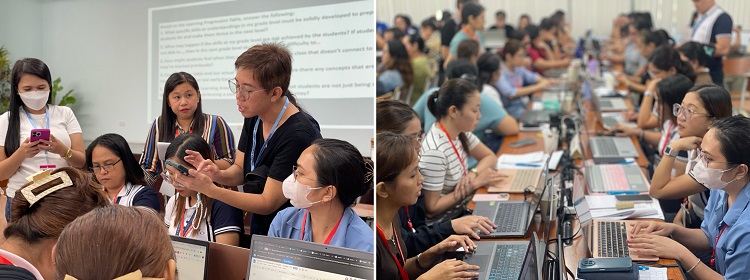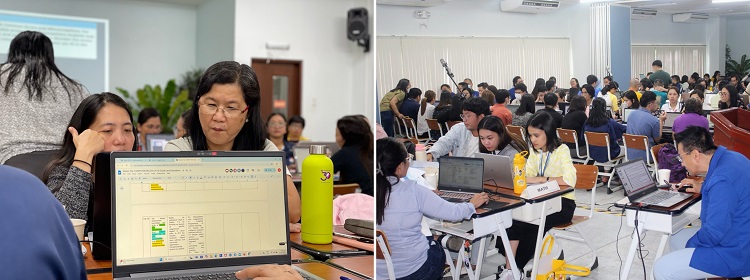by Juanito R Oliveria II
Correspondent: Franko Ray Santos

Photo by: Paulo C Fabrigar and Alcris John E Surial
In response to one of PAASCU recommendations, educators across all grade levels in Xavier University Basic Education units gathered to examine and align the entire K–12 curriculum, aiming to bridge learning gaps and ensure a more connected academic journey for students.
Held on 4 to 5 June at the XU Senior High School AVRs, the vertical articulation activity brought together faculty members from Grades 1 to 12 in a rare full-scale collaboration. The working theme of the event was “One Mission, Many Paths: Aligning with Purpose, Innovating with Spirit.”
The initiative marked a rare opportunity for teachers from grade school, junior high, and senior high to collaborate and examine all learning areas as part of a continuous academic journey for both teachers and students.
Connecting Curriculum from K to 12
Dr Mike Rapatan, the facilitator of the articulation compared the articulation activity as building a bridge across the whole learning journey, not just year by year.
Using curriculum maps, the Department of Education’s revised curriculum guide, and Tables of Specifications (TOS), participants identified where skills were repeated, where learning gaps existed, and where teaching could be more intentional.
According to a Grade School MAPEH teacher, Jessa Lorono, the articulation clarified the importance of ensuring that each competency is thoroughly developed before progressing to the next. Teachers note how overlooked repetitions or poorly timed skills could hinder deeper learning later on.
For Math Chairperson Lorievic Carmelotes, the experience offered a broader view as she believed that they were able to see the emphasis of the learning competencies across the level from K to 12.

Photos by: Paulo C Fabrigar and Alcris John E Surial
Lesson Planning with Purpose
Beyond identifying gaps, the process also encouraged teachers to rethink how they plan instruction. For Karen Samante, a Grade School Reading and Language teacher, it was a reminder that when planning for lessons, everything should be intentional in terms of assessment tools and foreseeing.
Teachers were asked to study their subject standards across all grade levels and determine how content progresses, or fails to establish continuity, through the years. Discussions in breakout rooms helped clarify where content needed to be reinforced or adjusted to better serve students’ learning paths.
In the Science area, Junior High teacher Christ Israel Millare said the review gave a clearer pathway for scientific skill development, allowing their group to identify where students need more structured preparation before moving to more complex concepts.
AI as a Curriculum Tool
A standout feature of the 2-day workshop was the integration of artificial intelligence in curriculum work. Dr Rapatan introduced Generative AI as a planning tool that could help teachers generate prompts, analyze strand progression, and clarify the flow of learning competencies using the "standards-in, standards-out" (SISO) approach.
Academic Chairperson for Filipino, Jennifer Galacio, highlighted how the use of AI created more accessible strategies for planning. “The articulation helped us develop easy ways to articulate and align by using and integrating AI in education,” she said.

Photos by: Paulo C Fabrigar and Alcris John E Surial
Teachers used AI-assisted prompts to create subject-specific maps showing how concepts and skills build across grade levels. This collaboration produced a working document that has become a shared reference point for faculty across departments.
Katrina Gabole, Grade School Computer teacher, shared, “We have created a unified and articulated master file containing all grade levels with the standards, progression, and skills, and suggested interventions to solve common errors and misconceptions.”
Collaboration Across Units
Department chairpersons facilitated small group sessions where teachers discussed their findings, shared sample rubrics, and analyzed common student difficulties. The sessions became a venue for collective conversation and collaborative problem-solving.
For Jose Rowel Damas, a Junior High School Social Studies teacher, the process went beyond curriculum review. “This helps achieve smoother learning progression for our students and promote stronger teacher collaboration across the units,” he added.
By the end of the two-day activity, what emerged was not just a better understanding of the curriculum, but also a sense of shared responsibility. The articulation laid the groundwork for future adjustments in teaching strategies, assessment tools, and intervention practices.
As Dr Rapatan reminded the participants, vertical articulation is not a one-time event but part of an ongoing effort to make each student’s learning journey more meaningful and even more connected.